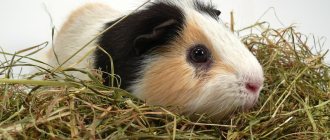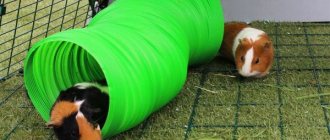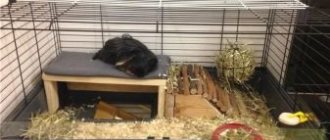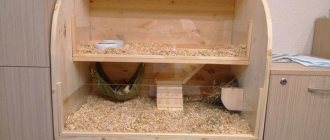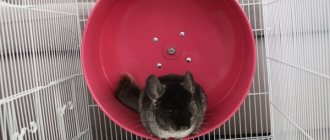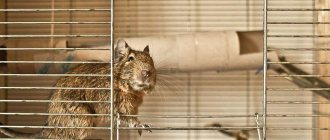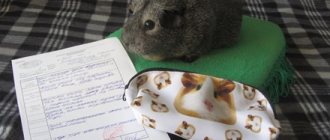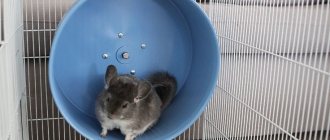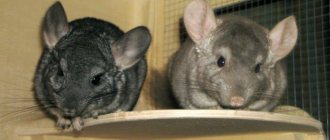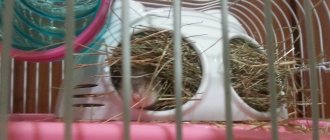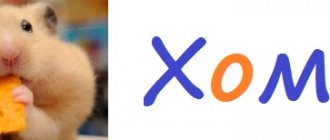Why does a guinea pig need hay?
Hay is a vital and essential component of a guinea pig's diet. The main issue is the quality of hay, because it differs in composition, freshness, fiber content and essential nutrients.
A rodent can live happily if it is kept in a fairly spacious cage, is healthy, and has plenty of hay and water. Dry plant foods are essential for healthy digestion and the prevention of dental problems. In addition, hay contains a surprising amount of nutrients that your guinea pig needs for proper growth, development, and overall health.
Regardless of the type of feeding you choose, your pet guinea pig should have unlimited access to fresh, quality hay on a daily basis.
In the wild, rodents have access to different types of vegetation. Wild relatives of guinea pigs feed on grass, shoots, branch bark, wild berries, fruits, and root vegetables.
A varied diet allows a wild rodent to provide itself with all the necessary nutrients, maintain the health of the digestive system and grind its teeth in a timely manner.
Note! All pets live in unnatural conditions, so the owner is responsible for adjusting the diet depending on living conditions.
Various household beddings
Many owners are so accustomed to certain bedding options that they don’t even think about their pros or cons, and this should be taken into account. This is how your favorite animal can live in comfortable conditions.
Coniferous shavings
If the shavings are made by hand, they must be dried and sifted. This will protect the animal's respiratory organs.
Wood shavings are a cheap and accessible filler that absorbs moisture well, however, it is better to use it only when there are no other options, because even a sifted and purified product can, in one way or another, cause harm to the guinea pig. Also, when the pet jumps and plays in the cage, shavings fly out.
Hay and straw
As bedding, hay and straw are not the best options. Hay can be used in combination with a soft, moisture-absorbing paper storage bag. This bedding is suitable for pigs with thick or coarse and short hair.
It is not recommended to use straw as bedding due to many disadvantages. It does not absorb moisture, can rot, has an unpleasant odor, and can also harm the animal, especially its eyes. Such bedding should be used only in special cases, when there are no other options, for a short time in combination with another filler, such as shavings.
When replaced regularly and used correctly, hay and straw can be used in conjunction with an absorbent storage tank. The advantage is that they contain vitamins, absorb, and also successfully imitate the wild environment, and every pig will like this.
Paper
This category of bedding includes all types of paper products in everyday life, except newspapers. This moisture-absorbing filler should only be used in conjunction with another - hay, fleece and PVC may be suitable. Newspaper cannot be used, since the printing ink on the pages is poisonous to the animal due to the lead in its composition.
It also has its advantages - this litter is cheap, hypoallergenic, easily accessible, and also safe for the pig’s paws. Due to the fact that paper gets wet very quickly and does not absorb odors, it is rarely used, unless absolutely necessary.
Other
Sometimes corn cobs are used as a filler, however, even with the naturalness of the litter, it absorbs and absorbs poorly, because of this it is recommended to use other fillers.
Cat litter can also be used as bedding. It absorbs well and eliminates unpleasant odors, is easy to dispose of, but we should not forget that silica gel poses a danger to the animal due to intestinal obstruction. And also this filler is expensive.
Bedding during childbirth
If a pig becomes pregnant, it should be moved to a separate housing. Before the event, you need to wash the cage, disinfect it and change the bedding, which is good for fresh small hay, as it is very soft.
Which hay is best for guinea pigs?
Many owners have questions, because hay is not the only food for guinea pigs that contains fiber. Not the only one, but the richest and lowest in calories. However, hay also varies; some types of grass contain large amounts of vegetable protein, natural sugar and calcium.
Since guinea pigs chew hay almost during the entire waking period, overeating and obesity are an obvious problem if plant foods are not selected correctly.
Note! A diet high in protein and calories is only suitable for pregnant, lactating and very young individuals.
You need to understand that the guinea pig’s body is physically unable to absorb a lot of protein and calcium, as a result of which, if fed improperly, sand and stones form in the animal’s bladder.
Main goals
In order for the bedding to be completely satisfactory for the pet and the owner, it must perform the following functions:
- Good to absorb. Combined soft bedding with filler absorbs moisture and eliminates odors.
- Protect the animal's paws. The soft surface without roughness protects the pig's limbs, preventing them from being injured.
- Give a satisfaction. A good filler will help the animal feel a natural sense of freedom, allowing it to sharpen its claws and dig into it as if in real soil.
Incorrectly selected bedding, as well as its irregular cleaning, will most likely lead to the following diseases: pododermatitis, urinary dermatitis, fungus, scabies, pediculosis, hair loss in pigs. To avoid unpleasant consequences, you need to monitor the cleanliness of your pet’s home and the naturalness of the bedding components.
There is no material without flaws, so often several layers of different fillers are used in the bedding so that it can accommodate the pet.
Ready-made hay from the store - selection rules
The composition of hay is not the only factor that you should focus on. Much more important is the quality and freshness of plant foods. The fresher the hay, the higher its nutritional value. It is important not to confuse calorie content with the content of essential nutrients. The longer the hay sits (stored), the more useless it becomes.
Meadow and grass hay is grown in the spring, and the first harvest occurs in early summer. Manufacturers of prepared food for rodents have long practiced re-growing - the cut grass is allowed to grow and harvested again.
Interesting! A pet store may sell a second or even a third crop. Moreover, the later the harvest, the lower the calorie content of the hay.
Ready-made hay from the store - selection rules:
- First Harvest – The grass stems of the first hay harvest have a clear structure and contain more fiber. The first harvest is healthier and contains young seed heads (tasty, but not as healthy), but differs from the second and third harvest in terms of toughness. It turns out that it is better to feed a guinea pig hay from the first harvest, but the pet itself will prefer the second.
- The second harvest is hay that is soft to the touch and large (wide). For guinea pigs, such food is tastier and more aromatic. Additionally, second harvest hay contains fewer seed heads and more stems, which is better for your teeth and digestive system.
- The third crop , hay, consists almost entirely of wide leaves and large stems. Third-cut hay is not very suitable for constant feeding, but guinea pigs like it. In addition, in terms of nutritional value, third-cut hay is close to bean hay or alfalfa.
Note! Pet stores often sell “pure” dried alfalfa. Guinea pigs love this grass and eat it with great pleasure. However, experts categorically do not recommend giving pigs a lot of alfalfa, much less replacing hay with it.
Optimal hay composition
There are many representatives of the flora that should be included in the finished collection. It is better to collect hay for guinea pigs according to the rules: it should contain timothy or other perennial grasses. The composition should contain several useful herbs.
Timothy is included in the best hay for guinea pigs
For pregnant females and young animals, it is necessary to make preparations based on alfalfa and legumes. This is due to the rich content of calcium and vegetable protein. This diet is not suitable for adults.
Rules for storing hay at home
Almost all pet stores sell hay packaged in plastic bags. After the expiration date, you risk purchasing a rotten mixture.
Rules for storing hay at home:
- Regardless of whether you bought hay or prepared it yourself, store the mixture only in open form.
- The humidity in the room where hay is stored should not exceed 40% in summer and 50% in winter.
- Turn and loosen the hay regularly to allow it to “breathe.”
If storage rules are violated, dry grass begins to rot. At first, a barely noticeable, sweetish odor appears. Afterwards the mixture begins to heat up and rot. As hay rots, mold may form on the hay.
Rules for feeding guinea pigs hay
Guinea pigs require a lifelong diet that is rich in fiber. It is thanks to the hay, which the pet chews almost around the clock, that its digestive tract can function smoothly and correctly.
Note! Guinea pigs' incisors grow quickly and throughout their lives. Constantly chewing rough food is the only way to wear teeth naturally.
The best way to provide your guinea pig with enough coarse fiber is to follow the rules for feeding guinea pigs with hay:
- You must know the composition of the hay and its origin.
- The hay should be fresh, dry and aromatic.
- Hay should be available to the pet around the clock.
Many owners face a common problem - their guinea pig wastes more hay than it eats. The pet drags hay around the cage and gets it dirty. This problem can be quickly solved with the help of a special feeder.
Polyvinyl chloride
A PVC mat is a lifesaver for many guinea pig owners. It is easy to use and easy to keep in good condition at all times. In order for such a bedding to last for a long time, you just need to shake it daily and wipe it with a damp cloth, and wash it once a week at 30 ⁰C. The rug must be laid on top of another material, for example, sawdust.
Such a rug has undeniable advantages: it protects animals’ paws and food from contamination, keeps garbage in one place, preventing it from scattering. There is only one minus - when pigs put a rug in the cage, they can chew through it and crawl under it. This disadvantage can be solved by securely securing the material so that animals cannot crawl under it.
What to do if your pig refuses to eat hay
The owner should be concerned if the pig refuses to eat hay. There are many possible reasons, but the most common ones are:
- Stale or rotten hay.
- The presence of poisonous herbs in the mixture.
- Problems in the gastrointestinal tract.
If your pet appears lethargic or weak while refusing hay, contact your veterinarian immediately. All diseases and dangerous conditions in guinea pigs develop rapidly, so delay can cost the pet’s life.
How to make hay with your own hands
If you live in an environmentally friendly area, you can make your own hay for your guinea pig. The obvious advantages are saving money and controlling the composition of the herbal mixture. Let us immediately note that making hay is not an easy task, requiring basic care and knowledge of the plant world.
See also: 5 reasons to get a Djungarian hamster
How to make your own hay:
- The grass is collected in June-July.
- Divide the grass clippings into three parts. We discard the bottom, use the top as hay for the first cut, and use the center as hay for the second cut.
- Never get the grass wet, even if it looks dirty. The grass must be dried, after which it can be cleaned with a brush.
- Dry the grass in a thin, even layer and only in the shade.
When harvesting herbs, it is important to ensure that unknown plants are not added to the mixture.
In nature, guinea pigs instinctively recognize poisonous plants; when they remove the hay themselves, this responsibility falls on the owner.
